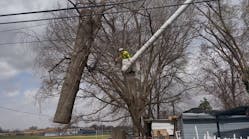3 Benefits Brush Control Programs Provide to Your Wildfire Mitigation Efforts
Utility vegetation management and wildfire mitigation efforts go hand in hand. Effectively controlling woody material – such as trees, shrubs and bushes – helps vegetation management teams eliminate key components that aid the spread of wildfires. Employing an effective brush control strategy provides three primary benefits to utility vegetation management programs working to effectively mitigate the threat of wildfire:
1. Ignition Prevention
Trees and other tall-growing plant species are the biggest threat to electrical transmission reliability. When these forms of tall vegetation grow or fall into transmission lines, it can often result in:
- Lapses in utility service
- Limited site accessibility
- Destructive wildfires
Considering these unfortunate outcomes, brush control continues to be a primary goal for most utility vegetation management programs across the country. Controlling problematic trees and brush species eliminates potential sources of wildfire ignition and helps to ensure the safe, reliable delivery of electrical service to utility customers.
2. Fuel Source Management
Utility infrastructure is just one of many sources of ignition for wildfires. From automotive accidents and deserted campfires to discarded cigarettes and intentional acts of arson, multiple sources of ignition are out of a vegetation manager’s control. But regardless of the source that caused a wildfire to occur, woody material trimmed from various brush species represent abundant sources of fuel that can expedite their spread – and the same can be said for tall grasses.
Luckily, certain brush control strategies can be used to control problematic plant species and promote the development of low-growing plant communities that enhance wildfire mitigation efforts and ensure electrical transmission reliability.
3. Offsetting the Elements
Understanding weather factors that increase the threat of wildfire can keep utility vegetation management teams prepared for the worst. Here are a few factors to consider when assessing the risk of wildfires in your respective area:
- Warmer temperatures support the growth and spread of wildfires. They expedite the evaporation of moisture that otherwise saturates the ground, soil and developing vegetation
- Snow is melting earlier each year and forests are now drier for longer periods of time.
- High winds expedite the spread of wildfire as oxygen reacts with burning fuels to release heat and generate combustion products that strengthen flames.
Climate change has led to warmer temperatures and extended drought-like conditions in regions across the country. As incompatible vegetation dries out, it becomes increasingly flammable. That is why it is important to control trees and tall-growing brush so that low-growing plant communities can flourish and safeguard surrounding communities from wildfires.
The Best Solution
Abiding by clearance requirements enforced by regulatory agencies is a primary goal of most utility vegetation management teams. However, different treatment strategies yield varying results. Mechanized mowing is effective but insufficient on its own. When used as a chief control method, mowing can actually stimulate regrowth and support the distribution of viable seeds. Failing to mow regularly can facilitate the growth of incompatible vegetation and increase incompatible stem densities. As stem densities increase, so do maintenance costs, lapses in utility service and the potential threat of wildfires.
While mechanized mowing provides short-term control of targeted vegetation, many Integrated Vegetation Management (IVM) programs apply selective herbicides to targeted vegetation to break the balance of biochemical processes in incompatible plant species, which effectively controls them and prevents their future development. With fewer hazards to manage, utility companies can enhance wildfire mitigation, prevent service interruptions and lower the cost of annual maintenance.
Using an IVM-based approach also helps vegetation managers convert the border zone (all land within 10 feet of a right-of-way’s edge) and wire zone (all land below wires and conductors as well as 10 feet beyond their outer edge) to include low-growing grasses and forbs, which effectively prevent the development of trees and tall-growing brush that pose a threat to fall or grow into utility infrastructure. Selective herbicide applications also leave desirable native plant species unharmed – unlike mowing practices.
Why is this important? As targeted species are effectively controlled, low-growing grasses and forbs develop to form a natural barrier against the future development of incompatible vegetation like trees and tall-growing brush species, providing multiple benefits to utility vegetation managers:
- Fewer lapses in utility service and wildfire events caused by electrical equipment
- Reductions in re-treatment expenses
- Elimination of ladder fuels: spreading wildfires remain close to the ground
- Established fuel breaks for firefighters
Vegetation management and wildfire mitigation efforts are year-round responsibilities for utility companies – particularly those located in western regions of the United States. While IVM strategies are effective in controlling incompatible vegetation and reducing the risk of wildfires, delaying or terminating IVM treatments can have adverse effects for utility vegetation management programs.



